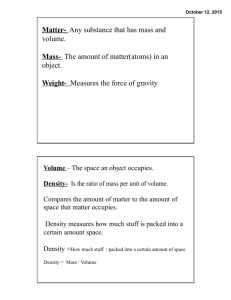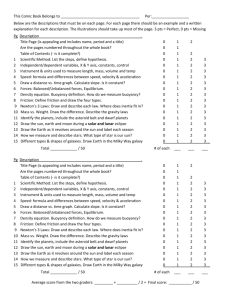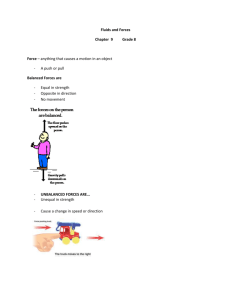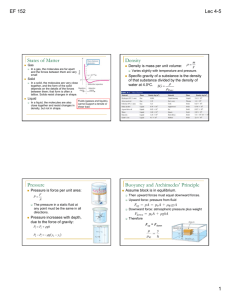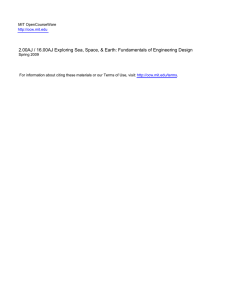Fluids and Structures Review
advertisement
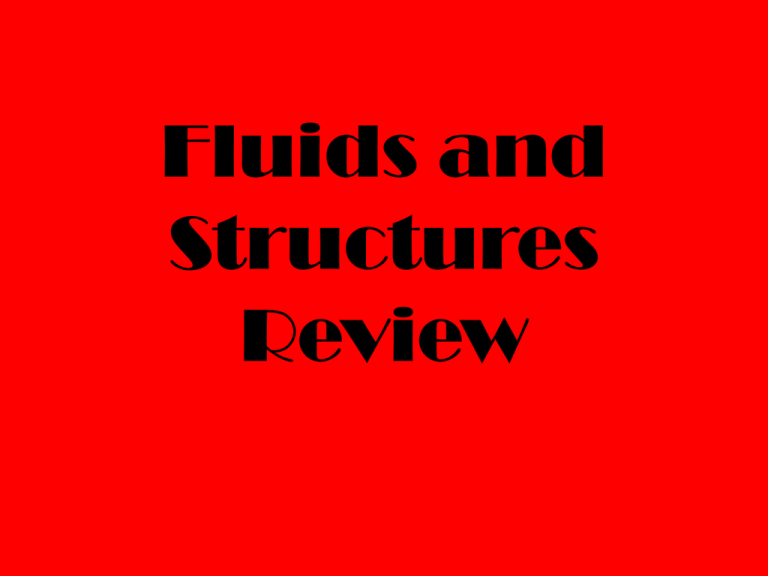
Fluids and Structures Review What is a fluid? • A fluid is something that flows and can be a liquid or gas. The two most common fluids are water and air. Name the three key points to the Particle Theory. 1. All matter is made up of particles. 2. Particles are in constant motion. 3. There are forces of attraction between particles. What is the difference between laminar and turbulent flow? • Laminar flow is the movement of a fluid in a straight or almost straight line. • Turbulent flow is the movement of a fluid in a broken or choppy pattern. What is viscosity? • Viscosity is the resistance a fluid has to flowing and movement. Describe the difference between a thick and thin fluid. • A thick fluid has a high viscosity and a slow flow rate. A thin fluid has a low viscosity and a high flow rate. What is the formula to calculate flow rate? • Flow rate = volume ÷ time Order these substances from greatest to least flow rate: ketchup 1.5 mL/s water 6.5 mL/s corn syrup 0.3 mL/s • The order for greatest to least flow rate is: Water, ketchup and corn syrup Describe the difference between weight and mass. • Mass is the amount of matter in an object and remains constant. Weight is a measurement of the force of gravity pulling on the object. It varies because gravity is different depending on where you are in the universe. What is the formula to calculate density? • Density = Mass ÷ Volume What is the difference between buoyancy and gravity? • Buoyancy is the upward force that acts on an object. Gravity is the downward force that acts on an object. Order these substances from least to most dense: Salt 2.16 g/mL Silver 10.5 g/mL Salt water 1.03 g/mL Ice 0.92 g/mL • The order from least to most dense is: Ice, salt water, salt and silver Name the three types of buoyancy. • The three types of buoyancy are positive buoyancy, neutral buoyancy and negative buoyancy. What is the difference between a hydraulic and pneumatic system? • A hydraulic system is a confined system that uses a liquid under a high pressure. A pneumatic system is a confined system that uses air under a high pressure. List the six types of simple machines. 1. 2. 3. 4. 5. 6. Lever Wheel and axel Pulley Screw Inclined plane Wedge What is the purpose of a machine? • To make the work that we do more efficent. Name the three classes of levers. • The three classes of levers are class 1, class 2 class 3. What is the formula to calculate mechanical advantage? • Mechanical Advantage= load force ÷ effort force • What is the difference between a fixed and moveable pulley? • A fixed pulley changes the direction of the force. A moveable pulley multiplies the force. How does friction relate to mechanical advantage? • Friction is a force that opposes movement. So friction makes things less efficient reducing a machine’s mechanical advantage. Name the three types of friction. • The three types of friction are rolling, sliding and fluid friction. What is the formula for calculating pressure? • Pressure = force ÷ area What would be the mechanical advantage of a lever that can lift 80N with an effort of only 20N? • Mechanical Advantage = load force ÷ effort force • MA = 80N ÷ 20N =4 How much pressure would be placed on a surface with an area of 2m2 if an object weighing 500N were sitting on it? • Pressure = Force ÷ Area = 500N ÷ 2 m2 = 250 N/m2

